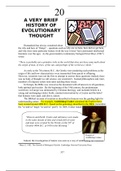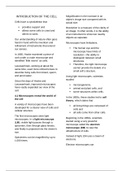- ISBN
- Author(s)
- Language
- Publisher
- Edition
- Edition
- Related:
Campbell Biology notes
Jane B. Reece, Martha R. Taylor, Eric J. Simon, Kelly A. Hogan, Jean L. Dickey - ISBN: 9780134240688
- ISBN
- Author(s)
- Language
- Publisher
- Edition
- Edition
- Related
View all 4 notes for Campbell Biology, written by Jane B. Reece, Martha R. Taylor, Eric J. Simon, Kelly A. Hogan, Jean L. Dickey. All Campbell Biology notes, flashcards, summaries and study guides are written by your fellow students or tutors. Get yourself a Campbell Biology summary or other study material that matches your study style perfectly, and studying will be a breeze.
Best selling Campbell Biology notes

Simple and summarized notes on cellular respiration from the Mastering Biology textbook. Includes notes on catabolic pathways, redox reactions, glycolysis, citric acid cycle, oxidative phosphorylation, chemiosmosis, fermentation/anaerobic respiration, and comparisons between aerobic and anaerobic respiration. Bullet point notes include pictures and diagrams straight from the textbook.
- Textbook notes
- • 8 pages •
Simple and summarized notes on cellular respiration from the Mastering Biology textbook. Includes notes on catabolic pathways, redox reactions, glycolysis, citric acid cycle, oxidative phosphorylation, chemiosmosis, fermentation/anaerobic respiration, and comparisons between aerobic and anaerobic respiration. Bullet point notes include pictures and diagrams straight from the textbook.

Delve in on evolutionary figures, foundational theories, and thoughts. This includes lots of background historical information that builds the foundation for the scientific theory of evolution.
- Class notes
- • 7 pages •
Delve in on evolutionary figures, foundational theories, and thoughts. This includes lots of background historical information that builds the foundation for the scientific theory of evolution.

Microscopes reveal the world of the cell. The small size of cells relates to the need to exchange materials across the plasma membrane. Prokaryotic cells are structurally simpler than eukaryotic cells. Eukaryotic cells are partitioned into functional compartments. The nucleus contains the cell's genetic instructions. Ribosomes make proteins for use in the cell and for export.
- Class notes
- • 5 pages •
Microscopes reveal the world of the cell. The small size of cells relates to the need to exchange materials across the plasma membrane. Prokaryotic cells are structurally simpler than eukaryotic cells. Eukaryotic cells are partitioned into functional compartments. The nucleus contains the cell's genetic instructions. Ribosomes make proteins for use in the cell and for export.

Many organelles are connected in the endomembrane system. The endoplasmic reticulum is a biosynthetic workshop. The Golgi apparatus modifies, sorts, and ships cell products. Lysosomes are digestive compartments within a cell. Vacuoles function in the general maintenance of the cell. A review of the structures involved in manufacturing and breakdown.
- Class notes
- • 3 pages •
Many organelles are connected in the endomembrane system. The endoplasmic reticulum is a biosynthetic workshop. The Golgi apparatus modifies, sorts, and ships cell products. Lysosomes are digestive compartments within a cell. Vacuoles function in the general maintenance of the cell. A review of the structures involved in manufacturing and breakdown.
Do you have documents that match this book? Sell them and earn money with your knowledge!
Newest Campbell Biology summaries

Simple and summarized notes on cellular respiration from the Mastering Biology textbook. Includes notes on catabolic pathways, redox reactions, glycolysis, citric acid cycle, oxidative phosphorylation, chemiosmosis, fermentation/anaerobic respiration, and comparisons between aerobic and anaerobic respiration. Bullet point notes include pictures and diagrams straight from the textbook.
- Textbook notes
- • 8 pages •
Simple and summarized notes on cellular respiration from the Mastering Biology textbook. Includes notes on catabolic pathways, redox reactions, glycolysis, citric acid cycle, oxidative phosphorylation, chemiosmosis, fermentation/anaerobic respiration, and comparisons between aerobic and anaerobic respiration. Bullet point notes include pictures and diagrams straight from the textbook.

Delve in on evolutionary figures, foundational theories, and thoughts. This includes lots of background historical information that builds the foundation for the scientific theory of evolution.
- Class notes
- • 7 pages •
Delve in on evolutionary figures, foundational theories, and thoughts. This includes lots of background historical information that builds the foundation for the scientific theory of evolution.

Microscopes reveal the world of the cell. The small size of cells relates to the need to exchange materials across the plasma membrane. Prokaryotic cells are structurally simpler than eukaryotic cells. Eukaryotic cells are partitioned into functional compartments. The nucleus contains the cell's genetic instructions. Ribosomes make proteins for use in the cell and for export.
- Class notes
- • 5 pages •
Microscopes reveal the world of the cell. The small size of cells relates to the need to exchange materials across the plasma membrane. Prokaryotic cells are structurally simpler than eukaryotic cells. Eukaryotic cells are partitioned into functional compartments. The nucleus contains the cell's genetic instructions. Ribosomes make proteins for use in the cell and for export.

Many organelles are connected in the endomembrane system. The endoplasmic reticulum is a biosynthetic workshop. The Golgi apparatus modifies, sorts, and ships cell products. Lysosomes are digestive compartments within a cell. Vacuoles function in the general maintenance of the cell. A review of the structures involved in manufacturing and breakdown.
- Class notes
- • 3 pages •
Many organelles are connected in the endomembrane system. The endoplasmic reticulum is a biosynthetic workshop. The Golgi apparatus modifies, sorts, and ships cell products. Lysosomes are digestive compartments within a cell. Vacuoles function in the general maintenance of the cell. A review of the structures involved in manufacturing and breakdown.
Do you have documents that match this book? Sell them and earn money with your knowledge!
Why study with the book summaries on Stuvia?

Relevance, efficiency and convenience. These are important elements when studying or preparing for a course or exam. Studying with the help of book summaries, which are linked to the ISBN number of your (study) book, is more relevant than ever. Your fellow students or tutors are sharing their knowledge to help you prepare for your exams. Find the ISBN number of your book and you'll be sure to buy the right summary. That way you won't be faced with surprises during your exams.

All summaries on Stuvia are written by students who have already taken the exam, lecturers who teach the study material or professional publishers. As a result, you can be confident that you will understand the course material more easily and that the summary contains all elements that are tested in the exam. Find the book you need to study by its ISBN and choose the best textbook summary.
